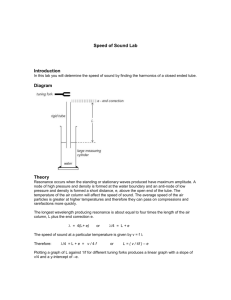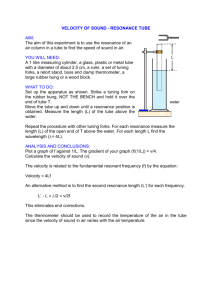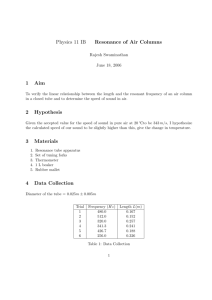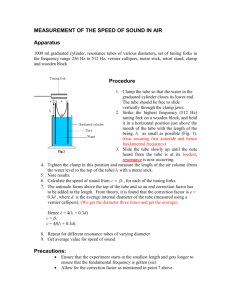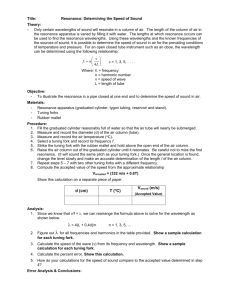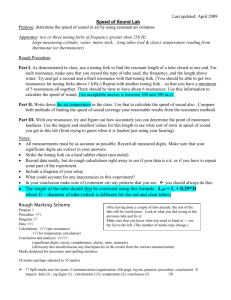Air Column Resonance: The Speed of Sound in Air Objectives
advertisement
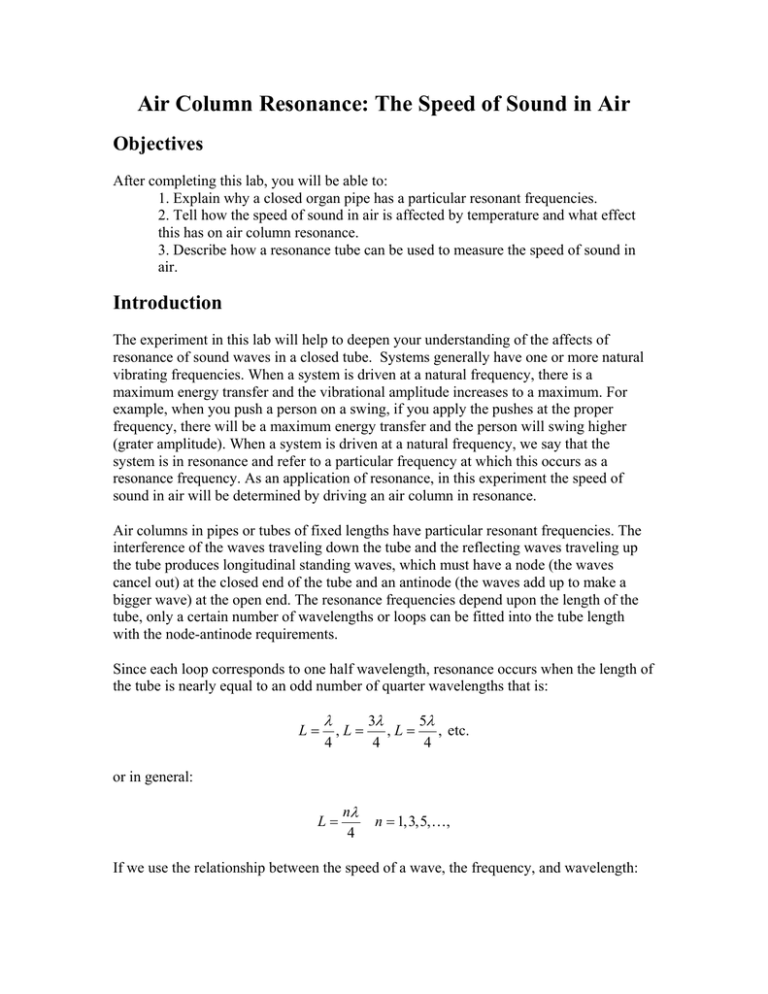
Air Column Resonance: The Speed of Sound in Air Objectives After completing this lab, you will be able to: 1. Explain why a closed organ pipe has a particular resonant frequencies. 2. Tell how the speed of sound in air is affected by temperature and what effect this has on air column resonance. 3. Describe how a resonance tube can be used to measure the speed of sound in air. Introduction The experiment in this lab will help to deepen your understanding of the affects of resonance of sound waves in a closed tube. Systems generally have one or more natural vibrating frequencies. When a system is driven at a natural frequency, there is a maximum energy transfer and the vibrational amplitude increases to a maximum. For example, when you push a person on a swing, if you apply the pushes at the proper frequency, there will be a maximum energy transfer and the person will swing higher (grater amplitude). When a system is driven at a natural frequency, we say that the system is in resonance and refer to a particular frequency at which this occurs as a resonance frequency. As an application of resonance, in this experiment the speed of sound in air will be determined by driving an air column in resonance. Air columns in pipes or tubes of fixed lengths have particular resonant frequencies. The interference of the waves traveling down the tube and the reflecting waves traveling up the tube produces longitudinal standing waves, which must have a node (the waves cancel out) at the closed end of the tube and an antinode (the waves add up to make a bigger wave) at the open end. The resonance frequencies depend upon the length of the tube, only a certain number of wavelengths or loops can be fitted into the tube length with the node-antinode requirements. Since each loop corresponds to one half wavelength, resonance occurs when the length of the tube is nearly equal to an odd number of quarter wavelengths that is: L= λ 4 ,L= 3λ 5λ ,L= , etc. 4 4 or in general: L= nλ 4 n = 1,3,5,…, If we use the relationship between the speed of a wave, the frequency, and wavelength: v = fλ then we have: fn = nv 4L Which means that the air column in the tube of length L has particular resonance frequencies and will be in resonance with the corresponding odd-harmonic driving frequencies. To study resonance in this experiment, the length L of an air column will be varied for a given driving frequency. The length of the air column will be varied by raising and lowering the level in the tube. As the length of the air column is increased, more wavelength segments will fit into the tube, consistent with the node-antinode requirements at the ends. The difference in the tube (air column) length when successive antinodes are at the open end of the tube and resonance occurs is equal to a half wavelength: ∆L = L3 − L2 = 5λ 3λ λ − = 4 4 2 When an antinode is at the open end of the tube, a louder resonance tone is heard. Hence, the tube lengths for antinodes to be at the open end of the tube can be determined by lowering the water level in the tube and listing for successive resonances. Procedure Part A To start you will move the tuning fork over the top of the tube of water, it will emit a tone. You will then have to lower the level of the water until you hear an increase in the volume of the sound (a sign you have reached resonance). You will then record the height of the air column (from the scale next to the tube) in your data table. You will then continue to lower the level of the water until you reach resonance again (i.e. the sound gets louder). You will have to continue this until you have two points of resonance. Record this distance also your data table. You will now need to take the difference of the distance you have measured and use the equations ∆L = λ 2 vs = f λ to find the speed of sound. Repeat this with the second tuning fork. Part B You will need to calculate the exact speed of sound so you can compare it to your results from the tubes. To do this you will need to know the temperature in Celsius. Record the temperature form the thermometer in the simulation. The speed of sound depends upon the temperature in a strait forward way. Using the following equation: vs = ( 331.5 + 0.6Tc ) m / s where vs is the speed of sound in m / s and Tc is the temperature in Celsius. Data Table: Tuning Fork 1 Frequency f __________ Tuning Fork 2 Frequency f __________ Position of resonance in Meters Position of ∆L in meters resonance in Meters L1 L1 L2 L2 λ λ Temperature vs (fork 1) vs (fork 2) Average vs vs from Temperature Percent Error ∆L in meters
